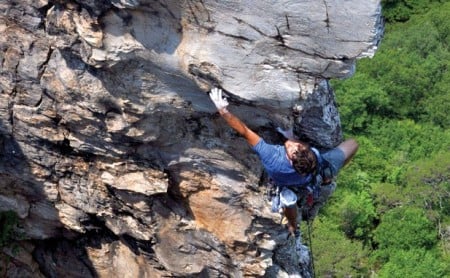School of Hard Rocks: A climber ascends the south peak of Seneca Rocks, W.Va. Photo: Massey Teel
From the gear and terminology to the fear factor, learning to climb can be intimidating. But the payoff is huge. Here is some crucial info to help you rock your first rock climb.
Three Ways to Climb
Top rope: The climbing rope is run through a fixed anchor point above the route, allowing the climber to send shorter routes without any extra protection on the wall.
Sport: Fixed protection is bolted into the rock wall, allowing climbers to clip into bolts as they send a route.
Traditional: Artificial protection (cams and wedges) is placed in grooves and cracks on the rock wall as the lead climber sends a route. The second climber then “cleans” or removes the protection as he follows up the route. Trad climbing is the most prevalent form of climbing in the Southeast.
Climbing Glossary
Anchor: The point where the rope is attached to the rock. Anchors are typically trees or bolts.
Belay: To secure a climber with a rope to minimize a fall. In a top rope scenario, the climber, anchor, and belayer form three points of contact with the rope.
Crux: The most difficult section of a climb.
Gripped: Overcome with fear and fatigue in the middle of a climb.
Lead climbing: To climb a route from the bottom up, placing artificial protection, or clipping into permanently placed bolts, along the way.
Multi-pitch: A long route that demands traditional protection placement. Each pitch of the climb must be shorter than a single length of rope (50 meters).
Protection: “Pro” for short, anchors placed by a lead climber to secure a climb.
Myth Busters
First, forget everything you think you know about rock climbing. Here are two common misconceptions dispelled:
1. Climbing is dangerous: Sure, you’re hundreds of feet off the ground strapped to a rock wall, but climbing is far safer than most non-climbers realize. According to a study released in 2008 by the American Alpine Club, climbers suffer fewer accidents than snowboards, skiers, and sledders.
“Knowledge is power,” says Swis Stockton, owner of Granite Arches, a service that guides beginners all over the Southeast. “A lot of beginners are scared to fall because they don’t realize the equipment is built for that very thing. If the ropes and harnesses are cared for, they’re much safer than most beginners think.
2. Climbing is about upper body strength: Sylvester Stallone made climbing looking brutally hard in Cliffhanger, but it’s not really about bulging biceps and huge “lats.”
“Climbing is about leg presses, not pull ups,” Stockton says. “Good climbers think about their foot placement first, moving from one foothold to the next, using their hands just for balance.”
Practice your footwork in the gym. Find a low-angled wall built for kids and try to traverse it using only your feet. If you can, keep your hands on your hips.








